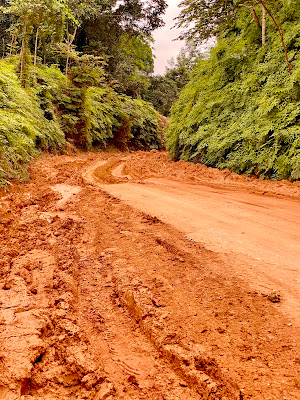 |
São Tomé, capital of São Tomé and Principe
São Tomé, Hauptstadt von São Tomé und Principe
|
 |
Our 'Robinson Crusoe' house
Unser 'Robinson Crusoe' Haus |
 |
Cool coffee shop
Cooles Café |
 |
Cacao fruit
Kakaofrucht |
 |
Impressions of the capital
Eindrücke aus der Hauptstadt |
 |
Waterfall Cascata de Sao Nicolau
Wasserfall Cascata de Sao Nicolau |
 |
Boy with wild raspberries
Junge mit wilden Himbeeren |
 |
| Roça Monte Café |
 |
Our 4x4 on the island
Unser 4x4 auf der Insel
|
 |
Beach with boats and baobab trees
Strand mit Booten und Baobabs |
 |
Petisqueira Santola, recommended eatery for crab enthusiasts
Petisqueira Santola, empfehlenswertes Lokal für Krebs-Liebhaber
|
 |
Nature prevails
Die Natur setzt sich durch
|
 |
Vegetable shop
Gemüsehändler
|
 |
Vanilla fermentation
Vanille Fermentierung
|
 |
| Vanilla |
 |
Freshly caught fish on the beach
Fangfrischer Fisch am Strand |
 |
| Bye-bye São Tomé |
The flight to São Tomé, a former Portuguese colony and (together with the smaller sister island of Principe) the second-smallest island state in Africa after the Seychelles, took just 45 minutes. Unfortunately, the car we booked was not at the airport and the renter, Walter, could not be reached by phone. What to do? We also needed Dobras, the local currency. In the meantime we could at least withdraw some money, we thought. But the ATM was empty. Welcome to the island paradise 😁 …
After almost two hours of waiting, a tour guide felt sorry for us, also because there were no taxis around, and he took us to town - for three times the price 😯. When we bought a SIM card, Walter finally showed up in the shop ... Well, with these few tourists, everyone on the island probably knows where they are.
On the black sandy beach
We checked different accommodations and opted for a beautiful tree house on a secluded black sandy beach lined with coconut palms. The lovely Portuguese owners lived right next door. In the following days they spoiled us with a variety of local and Portuguese food.
Cocoa & vanilla
The oval island of volcanic origin is approx. 45 km long and 30 km wide, pretty tropical, thus heavily overgrown and known for its high-quality cocoa beans and vanilla. At 2,024 m, Pico São Tomé is the highest mountain.
About 90 percent of the approximately 230,000 inhabitants live in the north, and the narrow streets lead around every hill, up and down. There were no 100 metres straight or flat route, at least that was our impression.
We often found the people to be unfriendly - and “busy bees” were hard to find. For example, even products that grow on the island were imported, such as coffee, sugar - and cocoa from Nestlé. The morbid charm of the old Portuguese buildings stood out pleasantly - or dismally, depending on your point of view.
Little sun & lots of chocolate
Since we arrived there in the time of the year with the most clouds we only saw the sun for a short time now and then. At least we enjoyed the beautiful bays, even some baobab trees, the warm Atlantic, lots of fresh fish and even more chocolate in different variations - with excellent mousse au chocolate as our clear favourite. In the end it looked like our clothes had shrunk a bit on the island 😂 …
However, ten days were enough, and we were looking forward to the flight back to Libreville.
Der Flug nach São Tomé, einer ehemaligen portugiesischen Kolonie und dem (gemeinsam mit der kleineren Insel Principe) zweitkleinsten Inselstaat Afrikas nach den Seychellen, dauerte nur 45 Minuten. Leider stand das gebuchte Auto nicht am Airport und der Vermieter Walter war telefonisch nicht erreichbar. Was tun? Wir brauchten ja auch Dobras, die Landeswährung. So könnten wir in der Zwischenzeit zumindest schon mal Geld am Automaten ziehen, dachten wir. Doch dieser war gerade leer. Willkommen im Inselparadies 😁 …
Nach fast zwei Stunden Wartezeit erbarmte sich ein Tourguide mangels Taxis, uns in die Stadt zu fahren - zum dreifachen Preis 😯. Als wir bei der Telefongesellschaft eine sim-Karte kauften, tauchte auch Walter endlich dort auf. Tja, bei den wenigen Touristen weiß wohl jeder auf der Insel, wo diese sich gerade aufhalten.
Am schwarzen Sandstrand
Wir schauten uns verschiedene Unterkünfte an und entschieden uns für ein schönes Baumhaus an einem einsamen, mit Kokosnusspalmen gesäumten schwarzen Sandstrand. Die netten portugiesischen Eigentümer wohnten direkt nebenan. Sie verwöhnten uns in den folgenden Tagen mit abwechslungsreichem lokalen und portugiesischen Essen.
Kakao & Vanille
Die ovale Insel vulkanischen Ursprungs ist ca. 45 km lang und 30 km breit, sehr tropisch, entsprechend stark bewachsen und bekannt für ihre qualitativ hochwertigen Kakaobohnen und Vanille. Der Pico São Tomé ist mit 2.024 m der höchste Berg.
Im Norden leben etwa 90 Prozent der ca. 230.000 Einwohner, und die engen Straßen führen um jeden Hügel herum, auf und ab. Manchmal hatten wir den Eindruck, es gibt keine 100 Meter gerade oder ebene Strecke.
Die Menschen empfanden wir häufig als abweisend und unfreundlich, und deren Arbeitswille auf ‘Limbo-Höhe’. So werden z.B. sogar Produkte importiert, die auch auf der Insel wachsen, wie Kaffee, Zucker - sogar Kakao, von Nestlé. Der morbide Charme der alten portugiesischen Gebäude stach wohltuend heraus - oder enttäuschend, je nach Sichtweise.
Kaum Sonne, aber jede Menge Schokolade
Da wir in der Jahreszeit mit der stärksten Bewölkung gelandet waren, sahen wir nur ab und zu kurz die Sonne. Dafür genossen wir die schönen Buchten, sogar einige Baobab Bäume, den warmen Atlantik, viel frischen Fisch und noch mehr Schokolade in verschiedenen Varianten - mit exzellentem Mousse au Chocolate als klarem Favoriten. Am Ende kam es uns so vor, als ob unsere Kleidung auf der Insel etwas eingegangen sei 😂 …
Zehn Tage waren allerdings genug und so freuten wir uns auf den Rückflug nach Libreville.




























































